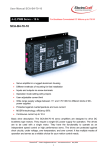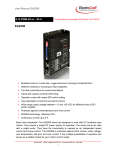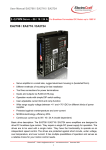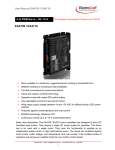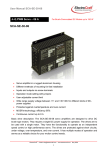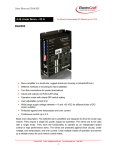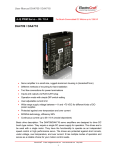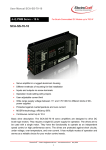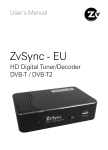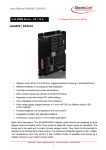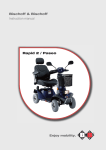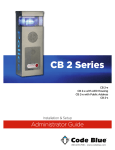Download PDF (Drive User Manual)
Transcript
User Manual SCO-B1-40-05-01 For Brushless-Commutated DC Motors up to 175 W 2–Q PWM Servo –05 A SCO-B1-40-05-01 • Brushless drive in a small compact open-frame aluminium module • Different methods of mounting for fast installation • Inputs and outputs via screw terminals • User adjustable current limiter • Wide range supply voltage between +12 and +40 VDC for different kinds of DCpower supplies • Protected against overtemperature and over-current • MOSFet-technology, efficiency 95% • Continuous current up to 5 A • Peak current up to 10 A Basic drive description: The SCO-B1-40-05-01 drives are designed to drive DC brushless type motors. They require a single DC power supply for operation. The drives are to be used with a single motor. They have the functionality to operate as an independent speed control. The drives are protected against short circuits, under voltage, over temperature, and over current. It has multiple possibilities of operation and serves as a reliable choice for your motion control needs. ElectroCraft® E-Mail: [email protected] 1 www.electrocraft.com May 2009 User Manual SCO-B1-40-05-01 Table of Contents 1. Safety & Installation ......................................................................... 3 2. Specifications: .................................................................................. 4 3. Drive Overview .................................................................................. 6 4. Wiring................................................................................................. 9 5. Explanation of Terminals & Potentiometers ................................ 15 6. Glossary .......................................................................................... 17 7. Description of Inputs and Outputs ................................................ 22 8. Accessories & Options .................................................................. 25 9. Basic Troubleshooting ................................................................... 26 10. Warranties & Disclaimers .............................................................. 27 11. Dimensions ..................................................................................... 28 Used Symbols Indicates a warning or caution concerning operations that may lead to death or injury to persons, or damage to property if not performed correctly. In order to use the drive safely, always pay attention to these warnings. Indicates a clarification of an operation, or contains additional explanations, or operational requirements for a procedure. Reading these notes is much recommended. ElectroCraft® E-Mail: [email protected] 2 www.electrocraft.com May 2009 User Manual SCO-B1-40-05-01 1. Safety & Installation The SCO-B1-40-05-01 requires installation by qualified personal which must pay attention to significant safety and other regulatory standards. They should be thoroughly familiar with the entire system before beginning installation. Before final operation of machine be sure to test hookup with motor disconnected from the load. Improper wiring could cause a “motor run away” condition, and cause serious injury or damage to the machine and personal. Before starting installation of the SCO-B1-40-05-01, be sure that main power is disconnected. After powering the drive it should not be touched by hand or risk shock. Take care that in case of regeneration or in brake operation the energy recovery must be buffered by the power supply and / or a braking module. Ensure with electronically stabilized power supplies that protection circuit isn’t react. Don’t switch off the power supply while the motor is turning, in this case the drive could be destroyed by regeneration. We recommend connecting a capacitor of 1000 µF per each ampere output current close to power input, in parallel. Do not repair or open drives enclosure. Result would result in personal injury and would void all warranties. The SCO-B1-40-05-01 is not complying with the European directive EN 61800-3 (1996) for his own but the following points can be helpful: • A metal mounting plate with correct grounding is mandatory. • For installation purposes, tooth lock washers have to be used. • For most wiring schemes, only shielded cables are admissible, to suppress interference with other devices. Damaged items have to be replaced. • Provide for a large contact area between shields and mounting plate. • The motor has to be grounded in the prescribed manner. • The drive is an Electrostatic Sensitive Device (ESD). Electrostatic discharge needs to be avoided. NOTE: Certain applications may involve special requirements. Consult Factory! ElectroCraft® E-Mail: [email protected] 3 www.electrocraft.com May 2009 User Manual SCO-B1-40-05-01 2. 2.1 Specifications: Electrical Data Power Supply Voltage +12 to +40 VDC (Residual ripple <5 %) (The lower limit is monitored integrated undervoltage trip) by WARNING: Do not exceed 40V. Overvoltage will damage the drive. Nominal Current 5A Peak Current 10 A Maximum Power (only achievable with additional heatsink < 1.8 K / W & proper mounting over a current of 3.5 A.) 175 W Switching Frequency 20 kHz Efficiency 95 % Induction Specification & caution for low Optional choke modules are often an inductance motors economical solution for low inductance or other motors, if an overheating situation occurs in regular intervals. Contact factory service for details. Power and signal terminals ElectroCraft® The diameter must be suited for the connecting wires of the current load. The recommendation is 1,5 mm2 (AWG16), the minimum is 0,13 mm2 (AWG28). Maximum wire diameter with respect to the terminal is 2,5 mm2 (AWG14).Strip the wire insulation of the cables on a length of maximal 8 mm. For stranded wire, use end sleeves with the corresponding length. E-Mail: [email protected] 4 www.electrocraft.com May 2009 User Manual SCO-B1-40-05-01 2.2 Mechanical Data Mechanical Dimensions L x W x H 90 x 50 x 30 mm Weight 125 g Mounting 2.3 2.4 M4 screws Ambient Conditions Operation Temperature -10 to +45 oC Storage Temperature -40 to +85 oC Humidity (Non Condensing) 20 % to 80 % RH Overtemperature Protection +80 °C Digital and Analog Inputs Disable (Dis) Open Collector / TTL / CMOS / Switch Direction (Dir) Open Collector / TTL / CMOS / Switch Brake Open Collector / TTL / CMOS / Switch Hall 1, 2, 3 (S1, S2, S3) TTL, +6 VDC; Resistance = 1 kOhm Set value (Sv) 2.5 Analog 0 – +5 VDC ; Resistance > 100 kOhm Outputs Auxiliary Voltage Outputs +6V +6 V / 10 mA Auxiliary Voltage Outputs S+ +6 V / 20 mA ElectroCraft® E-Mail: [email protected] 5 www.electrocraft.com May 2009 User Manual SCO-B1-40-05-01 3. Drive Overview 3.1 Block Diagram ElectroCraft® E-Mail: [email protected] 6 www.electrocraft.com May 2009 User Manual SCO-B1-40-05-01 3.2 Input & Output Schematics ElectroCraft® E-Mail: [email protected] 7 www.electrocraft.com May 2009 User Manual SCO-B1-40-05-01 3.3 Control Elements 3.4 Operation Modes Hall Mode At hall mode the feedback information is coming from hall switches which are mounted in the motor or a hall encoder which is mounted at the motor. The speed regulation is good at each load condition and qualified for each application to control the speed of a system also for high speed application. ElectroCraft® E-Mail: [email protected] 8 www.electrocraft.com May 2009 User Manual SCO-B1-40-05-01 4. Wiring According to the safety directives, a correct cable selection is mandatory. Regular inspection is advisable. Damaged, burned or kinked items have immediately to be exchanged. Power (Vcc - GND) • Normally no shielding required. • When connecting several amplifiers to the same supply pack, use star point wiring. Motor Wiring (> 30 cm) • Only shielded cables are recommended. • Connect the shield to the ground lug of the servo amplifier. • A separate cable has to be used. • Choke modules are useful to reduce PWM-pulses. Connection to hall (> 30 cm) • Only shielded cables are recommended. • Connect the shield to the controller. • A separate cable has to be used. Analog Signals (Sv) • In most cases no shielding required. This may be different for low level signals or in an environment with strong magnetic interference. • Connect the shield on either end of the cable. For 50/60 Hz interference, remove the shield on one side. Digital Signals (Dis; Dir; Brake) • No shielding required. To verify a trouble-free operation and the conformity to CE regulation, it makes only sense to test the system as a whole, with all components installed (motor, amplifier, supply pack, EMC filters cables etc.). Note: To improve the noise immunity, always connect unused logical inputs to a fix potential (GND or +6V). ElectroCraft® E-Mail: [email protected] 9 www.electrocraft.com May 2009 User Manual SCO-B1-40-05-01 4.1 Wiring Example I ElectroCraft® E-Mail: [email protected] 10 www.electrocraft.com May 2009 User Manual SCO-B1-40-05-01 4.1.1 Adjustment procedure for Example I 1. Potentiometer pre setting refer chapter 5.2. 2. To activate the drive switch the Dis and the Brake input to ground. 3. Set the internal Speed potentiometer to maximum speed. 4. Turn the potentiometer nmax, until the desired maximum speed is reached. 5. Adjust with the Imax potentiometer the maximum motor current to a value requested by you. It is of major importance that this value is lower than the maximum admissible constant current (see motor data sheet). To measure the motor current use a current probe in one of the motor cables with a oscilloscope or a multimeter. 6. To change rotation direction of the motor connect the /Dir input to ground. Note: In case of using the switches for Dir or Brake refer chapter 7.1. ElectroCraft® E-Mail: [email protected] 11 www.electrocraft.com May 2009 User Manual SCO-B1-40-05-01 4.2 Wiring Example II ElectroCraft® E-Mail: [email protected] 12 www.electrocraft.com May 2009 User Manual SCO-B1-40-05-01 4.2.1 Adjustment procedure for Example II 1. Potentiometer pre setting refer chapter 5.2. 2. Set the internal Speed potentiometer to the left stop. 3. To activate the drive switch the Dis input to ground. 4. Set the external Speed potentiometer to maximum speed. 5. Turn the potentiometer nmax, until the desired maximum speed is reached. 6. Adjust with the Imax potentiometer the maximum motor current to a value requested by you. It is of major importance that this value is lower than the maximum admissible constant current (see motor data sheet). To measure the motor current use a current probe in one of the motor cables with a oscilloscope or a multimeter. ElectroCraft® E-Mail: [email protected] 13 www.electrocraft.com May 2009 User Manual SCO-B1-40-05-01 4.3 Wiring Example III – Minimal Wiring ElectroCraft® E-Mail: [email protected] 14 www.electrocraft.com May 2009 User Manual SCO-B1-40-05-01 5. Explanation of Terminals & Potentiometers 5.1 Terminals Terminal Label Description Pin 1 input Direction (Dir). Pin 2 GND. Pin 3 input set value (Sv). Pin 4 voltage output +6 VDC. X1 Pin 6 & 5 connect to power supply. Pin 7 input Disable (Dis). Pin 8 input Brake (/Br). Pin 9 & 10 & 11 input for hall signals. Pin 12 voltage output + 6 VDC. X2 Pin 13 GND. Pin 14 & 15 & 16 connect to motor. ElectroCraft® E-Mail: [email protected] 15 www.electrocraft.com May 2009 User Manual SCO-B1-40-05-01 5.2 Potentiometers Potentiometer nmax Turning to the Left Turning to the (ccw) Right (cw) Value is decreased Value is increased Set value for max. current Increase the current Reduce the current Set the motor speed Decrease motor Increase motor speed speed Function Definition of max. number of revolutions Imax Speed Potentiometer setting for start up: n max I max Speed Middle Middle Left stop ElectroCraft® E-Mail: [email protected] 16 www.electrocraft.com May 2009 User Manual SCO-B1-40-05-01 6. Glossary nmax Use this potentiometer to adapt the desired maximum speed to the amplitude of the present set value. For Example: if maximum of 5V is to be used for maximum Speed then send 5V and adjust that maximum with the nmax potentiometer. Take care not to exceed meaningful limits. An exaggerated value may avoid to control the drive and making it impossible e.g. to line-up the system in speed control operation under load. Imax The following action requires the motor to be operated with maximum load. The motor current may be measured e.g. using current probe with effective value display, or by means of an ammeter located in the motor line. Imax decide on the maximum possible motor current. The following limits have to be observed: - Left stop: 5 % of rated current of 5 A - Right stop: 100 % of rated current + (0 – +20 %) Note: Do not overheat the motor. For this reason, the Imax limit should always be selected lower than the maximum admissible constant current. The peak current of the drive can be rise up to 10 A. Speed The function for the Speed-potentiometer is to adjust the motor speed. Hall mode This is a closed loop speed mode which is using the hall signals as a feedback input for the speed. ElectroCraft® E-Mail: [email protected] 17 www.electrocraft.com May 2009 User Manual SCO-B1-40-05-01 Brushless motor A class of motors that operate using electronic commutation of phase currents, rather than electromechanical (brush-type) commutation. Brushless motors typically have a permanent magnet rotor and a wound stator. Commutation Is a term which refers to the action of steering currents or voltages to the proper motor phases so as to produce optimum motor torque. In brush type motors, commutation is done electromechanically via the brushes and commutator. In brushless motors, commutation is done by the switching electronics using rotor position information obtained by Hall sensors. Hall sensor Is a feedback device which is used in a brushless servo system to provide information for the amplifier to electronically commutate the motor. The device uses a magnetized wheel and hall effect sensors to generate the commutation signals. Back EMF The voltage generated when a permanent magnet motor is rotated. This voltage is proportional to motor speed and is present regardless of whether the motor winding(s) are energized or de-energized. Closed loop This is broadly applied term, relating to any system in which the output is measured and compared to the input. The output is then adjusted to reach the desired condition. In motion control, the term typically describes a system utilizing a velocity and/or position transducer to generate correction signals in relation to desired parameters. Cogging A term used to describe non-uniform angular velocity. Cogging appears as jerkiness, especially at low speeds. Continuous rated current The maximum allowable continuous current a motor can handle without exceeding the motor temperature limits ElectroCraft® E-Mail: [email protected] 18 www.electrocraft.com May 2009 User Manual SCO-B1-40-05-01 Continuous stall torque Is the amount of torque at zero speed, which a motor can continuously deliver without exceeding its thermal rating. To determined by applying DC current through two windings with locked rotor, while monitoring temperature. It’s specified with motor windings at maximum rated temperature and 25 °C ambient temperature, motor mounted to a heat sink. Refer to individual specs for heat sink size. Controller This term describes a functional block containing an amplifier, power supplies, and possibly position-control electronics for operating a servomotor or step motor. Demag current Is the current level at which the motor magnets will start to be demagnetized. This is an irreversible effect, which will alter the motor characteristics and degrade performance. Drive It‘s an electronic device that controls torque, speed and/or position of an AC or brushless motor. Typically a feedback device is mounted in or on the motor for closed-loop control of velocity and position. Driver Is the electronics which convert step and direction inputs to high power currents and voltages to drive a step motor. The step motor driver is analogous to the servomotor amplifier's logic. Efficiency The ratio of power output to power input. Encoder Is a feedback device which converts mechanical motion into electronic signals. The most commonly used, rotary encoders, output digital pulses corresponding to incremental angular motion. For example, a 1000-line encoder produces 1000 pulses every mechanical revolution. The encoder consists of a glass or metal wheel with alternating transparent and opaque stripes, detected by optical sensors to produce the digital outputs. ElectroCraft® E-Mail: [email protected] 19 www.electrocraft.com May 2009 User Manual SCO-B1-40-05-01 Feedback It is a signal which is transferred from the output back to the input for use in a closed loop system. Four quadrants Refers to a motion system which can operate in all four quadrants; i.e., velocity in either direction and torque in either direction. This means that the motor can accelerate, run, and decelerate in either direction. Gain The dynamical behaviour of the servo amplifier must be compatible to the particular connected motor. The adjusting procedure is performed using the Gain potentiometer. A bad adaptation (i.e. if the Gain value has been selected too high) can be easily recognized by excessive motor vibration or noise. Consequential mechanical damages cannot be excluded; furthermore an overtemperature situation may arise, due to high currents inside the motor. Inductance The electrical equivalent to mechanical inertia; that is, the property of a circuit, which has a tendency to resist current flow when no current is flowing, and when current is flowing has a tendency to maintain that current flow. NTC - Negative Temperature Coefficient A negative temperature coefficient thermistor is used to detect and protect a motor winding from exceeding its maximum temperature rating it is also used in a servo amplifier. Resistance of the device decreases with an increase in temperature. Open-loop A system in which there is no feedback. Motor motion is expected to faithfully follow the input command. Stepping motor systems are an example of open-loop control. ElectroCraft® E-Mail: [email protected] 20 www.electrocraft.com May 2009 User Manual SCO-B1-40-05-01 Pulse Width Modulation (PWM) 1. A PWM controller (amplifier) switches DC supply voltage on and off at fixed frequencies. The length of the on/off interval or voltage waveform is variable. 2. Pulse width modulation (PWM), describes a switch-mode (as opposed to linear) control technique used in amplifiers and drivers to control motor voltage and current. PWM offers greatly improved efficiency compared to linear techniques. Regeneration The action during motor braking, in which the motor acts as a generator and takes kinetic energy from the load, converts it to electrical energy, and returns it to the amplifier. Resonance Oscillatory behavior caused by mechanical limitations. Ringing Is an oscillation of a system following a sudden change in state. Speed Describes the linear or rotational velocity of a motor or other object in motion. Tachometer A small generator normally used as a rotational speed sensing device. The tachometer feeds its signal to a control which adjusts its output to the motor accordingly (called "closed loop feedback" control). Thermal protection A thermal sensing device mounted to the motor to protect it from overheating. This is accomplished by disconnecting the motor phases from the drive in an over temperature condition. ElectroCraft® E-Mail: [email protected] 21 www.electrocraft.com May 2009 User Manual SCO-B1-40-05-01 Torque Is a measure of angular force which produces rotational motion. This force is defined by a linear force multiplied by a radius; e.g. lb-in or Nm. Torque is an important parameter of any motion control system. Torque mode In this mode the driver controls only the current of the motor. The speed of the motor depends on the load because only the output force of the motor is regulated. Two Quadrants Refers to a motion system which can operate in two quadrants by changing the direction of the motor speed ore in one quadrant with active accelerate and decelerate. Watt One horsepower equals 746 watts. 7. 7.1 Description of Inputs and Outputs Digital Inputs Dis - Disable: Activating or Disabling the Output Stage If the Dis input X1/7 is at GND potential or LO, the output stage remains in the locked state. The motor stands still or slow down without brake. The output stage is activated if not wired at all or a voltage signal >3.5 V is set to the Dis input. Additional information about the schematic refer chapter 3.2. Range of Input Voltage 0 to +24 VDC Input Impedance >100 kOhm Drive disabled <0.6 VDC or connected to GND Drive activated >3.5 VDC or open ElectroCraft® E-Mail: [email protected] 22 www.electrocraft.com May 2009 User Manual SCO-B1-40-05-01 Dir - Direction: Changing the Direction of the Rotation If the Dir input X1/1 is at LO the motor turns in clockwise or counter clockwise, at HI or open he works in the opposite direction. The direction depends by the commutation sequence of the motor. Additional information about the schematic refer chapter 3.2. Range of Input Voltage 0 to +24 VDC Input Impedance >100 kOhm Direction e.g. CCW-rotation <0.6 VDC or connected to GND Direction e.g. CW-rotation >3.5 VDC or open Note: It is to avoid changing the direction on fly; otherwise the motor also the drive can be damaged. For changing the direction please follow this way: • Disable to LO, wait until motor has stopped • Change the Dir level • Enable auf HI, motor is working in the other direction S1 / S2 / S3: Hall Feedback of the Motor The hall inputs X2/9, X2/10 and X2/11 are connected to the hall signals of the motor. The supply voltage is given by the S+ output at X2/12 and GND (X2/13). The drive needs the signals to do the commutation and control the speed. Additional information about the schematic refer chapter 3.2. Range of Input Voltage 0 to +6 VDC Input Impedance >10 kOhm Permanent Input Protection -0.6 to +24 VDC High level >2,4 VDC Low level <1 VDC ElectroCraft® E-Mail: [email protected] 23 www.electrocraft.com May 2009 User Manual SCO-B1-40-05-01 Brake: Braking the Motor If the Brake input X1/8 is at LO potential or GND is the function not activated (active – LO). At HI or not wired the motor is breaking suddenly by shorting the motor windings to GND, even if the Enable input is switched off. Additional information about the schematic refer chapter 3.2. Range of Input Voltage 0 to +24 VDC Input Impedance >100 kOhm Brake disabled <0.6 VDC or connected to GND Brake activated >3.5 VDC or open Note: Don’t exceed the maximum breaking speed, otherwise the output stage could be destroyed. The maximum allowed breaking speed is limited by the maximum permitted short circuit current and the maximum allowed kinetic energy: • I <= 8 A • Wk <= 4 Ws By the motor data’s it is possible to calculate the maximum breaking speed: max. allowed braking speed limited by current [ n max = 8 A • k n • (RPh − Ph + 0.08Ω ) min −1 -1 ] -1 kn = Speed Constant [min V ] (I = 8 A) RPh-Ph = Terminal Resistance Phase-Phase [Ω] At a given moment of inertia the maximum breaking speed is calculated as follow: [ max. allowed braking speed limited by kinetic energy n max = (Wk = 4 Ws) JR = Rotor Inertia [gcm ] 365 •10000 min −1 JR + JL 2 2 JL = Load Inertia [gcm ] ElectroCraft® E-Mail: [email protected] 24 www.electrocraft.com May 2009 ] User Manual SCO-B1-40-05-01 7.3 Analog Inputs Sv: Set Value Input for Speed An external analog signal for speed entered using Sv input X1/3. If the voltage is lower than 0.5 V, the motor stops. If the voltage is positive the drive is working in the regulation area. Over 5 V the motor is unregulated with a limited maximum speed through the nmax potentiometer. Additional information about the schematic refer chapter 3.2. Range of Input Voltage 0 V to +5 V Input Impedance >100 kOhm Permanent Input Protection -0,6 V to +30 V Remark: If the external Sv input is used for the set value the Speed potentiometer has to rotate to the left stop. 8. Accessories & Options • Choke modules IA3100 (with 3 x 50 µH) and IA3101 (with 3 x 100 µH) ElectroCraft® E-Mail: [email protected] 25 www.electrocraft.com May 2009 User Manual SCO-B1-40-05-01 9. Basic Troubleshooting Motor runaway • The logic of the hall connection is permuted. • Reduce the maximal speed with pot nmax. Motor noise • Use additional choke in the motor Motor has no torque • Increase the admissible current with Imax pot. Motor drifts at standstill • The input value for the set value isn’t stable. Motor is going hot • Use an additional choke in series with the motor (see accessories). Motor speed too low • Increase the range with pot nmax. • Increase the admissible current with Imax pot. • Supply voltage too low. No motion even though enable is on • Check power supply and the wiring. • Overheating protection is active. • Check the polarity of the motor windings and hall signals. • Is the phasing (120°) of the hall correct? • The polarity of the motor windings or hall signals is permuted. • The feedback loop is open. Check wiring. Over temperature • Use an additional cooling. • Reset the amplifier. Note: Beware that the maximal working temperature of 80°C in the driver is not reached; otherwise the drive will be switched off. ElectroCraft® E-Mail: [email protected] 26 www.electrocraft.com May 2009 User Manual SCO-B1-40-05-01 10. Warranties & Disclaimers • Contents are subject to change without notice. • Electrocraft will not be liable in any way for direct, indirect, incidental, or consequential damages caused by the use of this product or document. • Per Electrocraft’s Terms & Conditions, the user of Electrocraft’s accepts all responsibility and risks involved with applying this product into their machinery and indemnifies Electrocraft against all damages. • Any reproduction of this product and document is strictly prohibited! Limited Warranty: Electrocraft products unless otherwise stated in specifications, are warranted for a period of 18 months from date of shipment, to be free from defects in materials, workmanship, and to conform to the specifications. Liability under this warranty shall be limited to the repair or replacement but not to the installation of any defective product at Seller’s option. Products will be repaired or replaced at the Seller’s option. Under no circumstance shall the user repair or modify the product. Failure to adhere to this will void all warranty. For Warranty, Repair, or Technical Assistance contact: Customer Support, North America / USA & Canada Motion Control Technologies: (800) 697-6715 Email: [email protected] Customer Support, Europe (except Germany), Middle East, Africa, Australia, Central & South America Customer service at +44 (0) 127 050 8800 Email: [email protected] Customer Support, Germany Customer service at +49 (0) 711 727205 0 ElectroCraft® Email: [email protected] E-Mail: [email protected] 27 www.electrocraft.com May 2009 User Manual SCO-B1-40-05-01 11. Dimensions 50,0 60,0 80,0 90,0 30,0 4 x Ø 4,4 15,0 4 x Ø 4,4 30,0 25,6 10,0 All dimensions in mm. SCO-B1-40-05-01_E09 Subject to change without prior notice. ElectroCraft® E-Mail: [email protected] 28 www.electrocraft.com May 2009




























